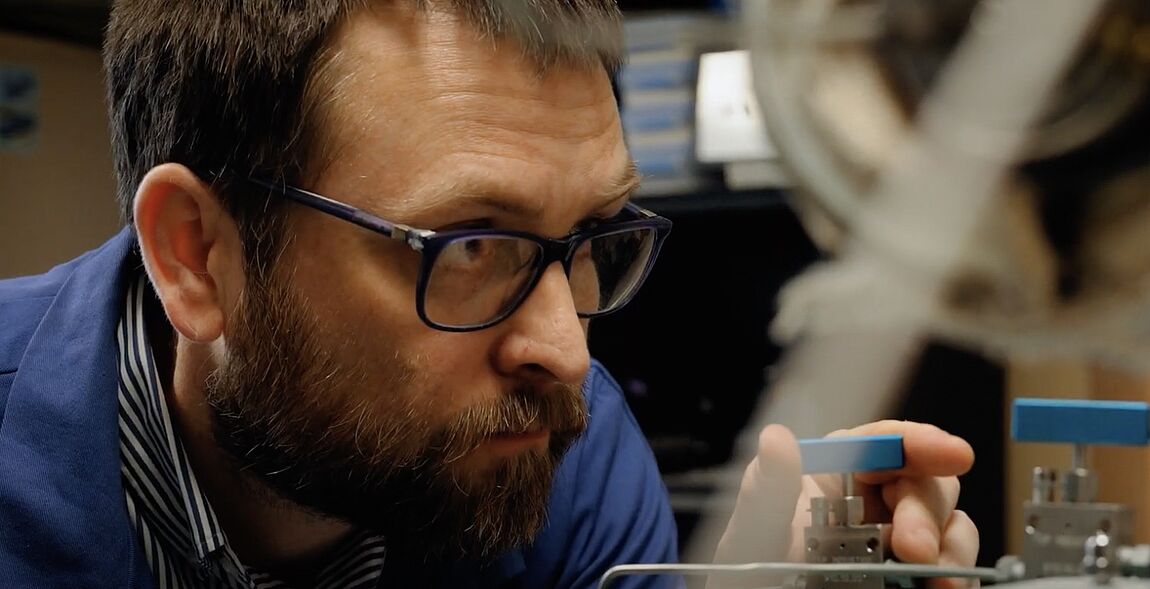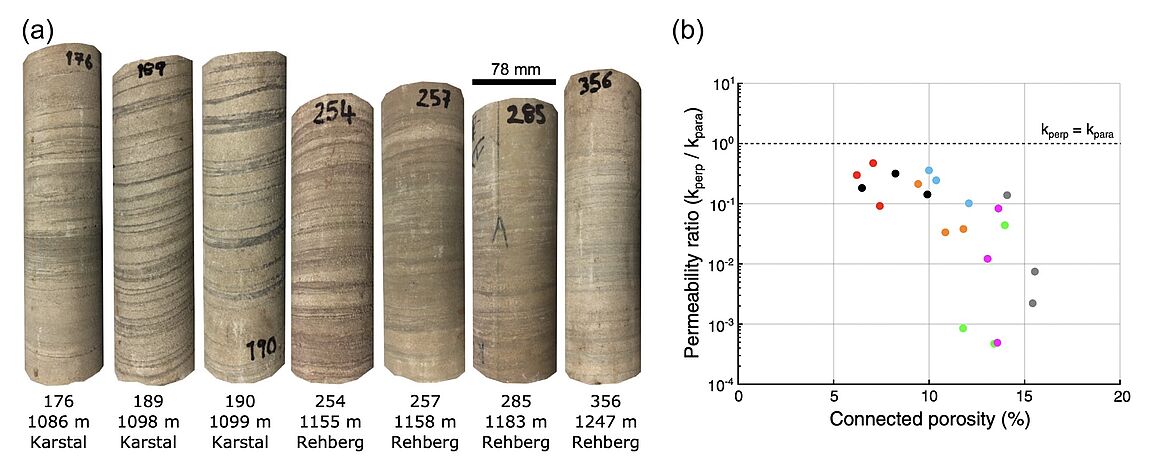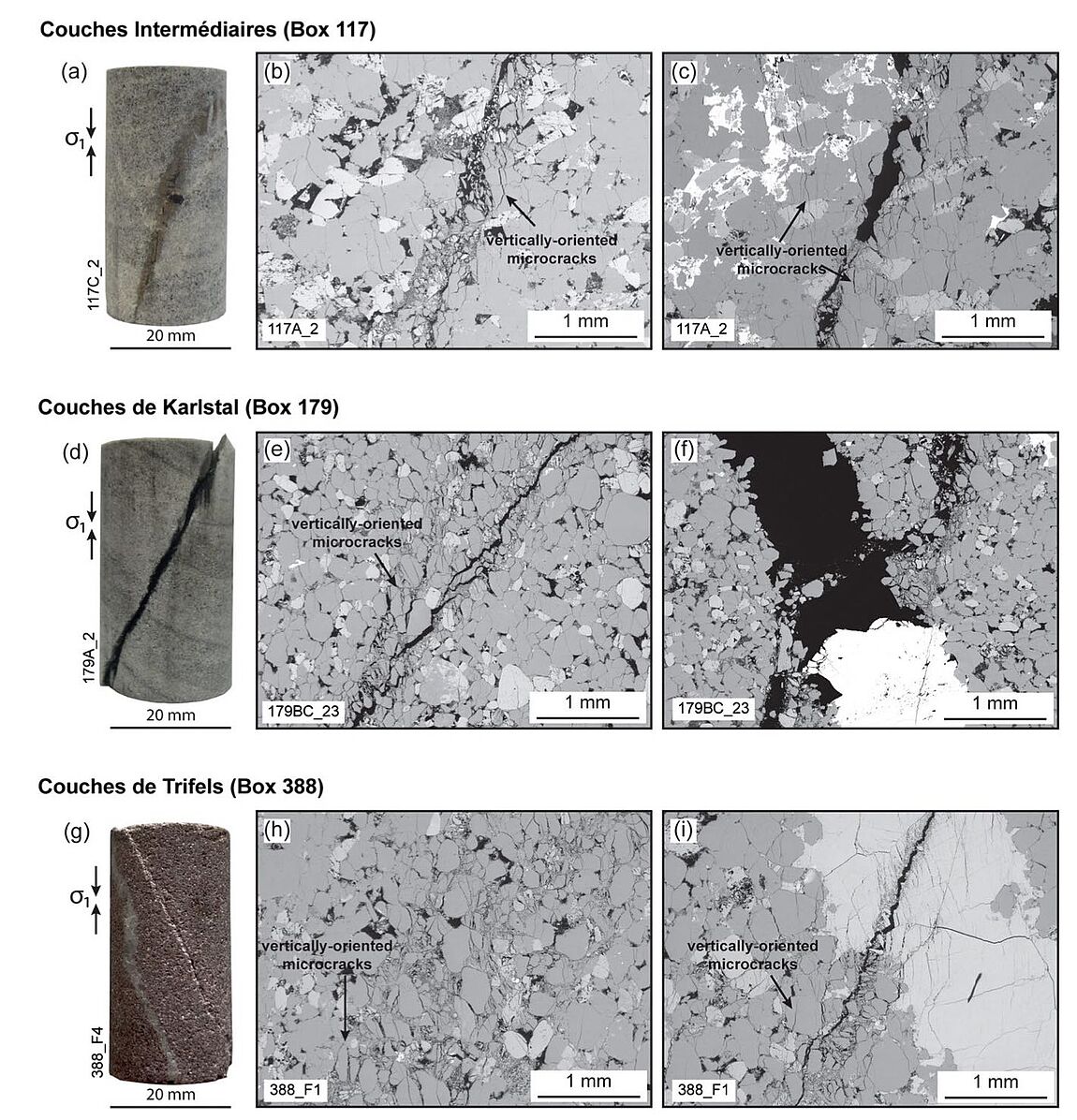Le groupe de travail « Physique des roches et géomécanique » a pour objectif principal de fournir des données de laboratoire sur les propriétés mécaniques, physiques et hydrauliques des roches afin de mieux comprendre les sujets liés à la transition énergétique. Pour ce faire, il utilise divers équipements spécialement conçus à l'Institut de la Terre et de l'Environnement de Strasbourg (ITES) pour étudier le comportement de déformation et les propriétés d'écoulement des fluides de la croûte terrestre.
Réalisations
Le WG4 a été très productif depuis le début du projet ITI GeoT. Il a publié plusieurs articles dans des revues à comité de lecture sur le thème de la transition énergétique, il a obtenu plusieurs subventions internationales et collaboratives axées sur l'exploitation de l'énergie géothermique, et il a gagné de nombreux nouveaux collaborateurs nationaux et internationaux.
Bien qu'il n'ait pas encore approfondi les expériences visant à étudier la séquestration du CO2, le groupe a publié deux articles portant sur les interactions entre les roches et les fluides : « Influence of water on deformation and failure of gypsum rock » et »Effect of water on sandstone's fracture toughness and frictional parameters : Brittle strength constraints ». En 2024, d'autres expériences et collaborations potentielles liées à la séquestration du CO2 et aux interactions roche-fluide seront développées avec l'Institut géotechnique norvégien.
L'objectif du groupe d'explorer la géothermie volcanique et le potentiel géothermique des zones de faille a très bien progressé. En ce qui concerne le volcano-géothermique, le WG4 a remporté une subvention ULYSSES du Partenariat Hubert Curien (PHC) avec des chercheurs en Irlande pour étudier « Renewable energy extraction from volcanoes : Exploring the geothermal potential of volcanic calderas » en 2021 et, en 2022, il a publié un article intitulé “Geothermal potential of small sub-volcanic intrusions in a typical Icelandic caldera setting”.
Concernant le potentiel géothermique des zones de failles crustales, le WG4 a obtenu une subvention ANR de 798 k€, pilotée par le BRGM, pour étudier « Geothermal resources of crustal fault zones : exploring new systems for competitive geothermal power production » (GERESFAULT). Dans ce cadre, une post-doc a été engagée. Sur un sujet similaire, le WG4 a également remporté, avec nos collègues du Geological Survey of Finland, une subvention de l'Académie de Finlande d'un montant de 999 k€ pour étudier « Discovering deep geothermal resources in low-enthalpy crystalline settings » en 2023. Dans le cadre de cette subvention, le groupe a publié un article, également en 2023, intitulé « Hydrothermally altered shear zones : a new reservoir play for the expansion of deep geothermal exploration in crystalline settings ».
Enfin, le WG4 a poursuivi ses travaux sur l'exploitation locale de l'énergie géothermique dans le Fossé Rhénan supérieur, ce qui a donné lieu à la publication de deux articles (« Reactivation of variably sealed joints and permeability enhancement in geothermal reservoir rocks » et « Permeability anisotropy in sandstones from the Soultz-sous-Forêts geothermal reservoir (France) : implications for large-scale fluid flow modelling »).
Figure 1. (a) Photographies de carottes de grès laminés de Buntsandstein prélevées dans le forage EPS-1 à Soultz-sous-Forêts (France). (b) Graphique du rapport de perméabilité (perméabilité perpendiculaire au lignage divisée par la perméabilité parallèle au lignage) en fonction de la porosité pour les carottes présentées dans le panneau (a). Le graphique montre que tous les grès laminés sont caractérisés par une anisotropie de perméabilité. Figures tirées de Goupil et al. (2022).
Figure 2. (a, d, et g) Photographies de carottes déformées de grès de Buntsandstein prélevées dans le forage EPS-1 à Soultz-sous-Forêts (France), contenant des joints partiellement remplis ou remplis. Les échantillons ont été déformés dans des conditions triaxiales. (b, c, e, f, h, et i) Images au microscope électronique à balayage (MEB) des échantillons déformés montrant la relation entre les joints partiellement remplis ou remplis et la fracture qui s'est formée dans l'échantillon à la suite de la déformation. Figures tirées de Kushnir et al. (2023).
Figure 3. (a) Colonne stratigraphique montrant la formation du Buntsandstein (de l'anté-Annweiler à Voltzia) et le réservoir granitique situé en dessous. A côté de la colonne se trouve la densité des fractures du forage (en rouge). (b) Force de compression mise à l'échelle de la formation de Buntsandstein et du réservoir granitique dans des conditions humides (ligne noire) et sèches (ligne grise en pointillés). Figures tirées de Heap et al. (2019).

Équipe
Leader : Michael Heap (ITES)
- Membres (EOST/ITES) : Patrick Baud, Thierry Reuschlé, Bertrand Renaudie
- Post-doc : Lucille Carabillet (2023-2024)
- Étudiants PhD : Sarvar Mammadov, Kamal Bayramov, Jalileh Nasseri
Collaborations
Avec les autres WG de l'ITI GeoT :
WG3 : Méthodes potentielles
WG6 : Géologie
Avec d'autres partenaires académiques :
M. Violay (EPSL, Switzerland)
A. Kushnir (EPFL, Switzerland)
N. Brantut (UCL, UK)
A. Bishoff Geological Survey of Finland
L. Griffiths (Norwegian Geotechnical Institute Olso, Norway)
F. Renard (University of Oslo, Norway)
T-F. Wong (University of Hong Kong, Hong Kong)
F. Meng (Sun Yat-sen University Zhuhai, China)
Northeastern University Shenyang, China)
Avec des acteurs socio-économiques :
BRGM, Orléans
Publications
Creep Properties and Transient Strength Enhancement of Sandstone in Acidic versus Distilled Water: Mechanisms of Precipitation Sealing. Xue, Y. Xu, T., Heap, M.J., Sun, W., Liu Y., Liu Z. (2025).Construction and Building Materials. https://doi.org/10.1016/j.conbuildmat.2025.144645
Decrease in the Permeability of Microcracked and Macrocracked Granite at Elevated Pressure and Temperature. L. Carbillet, M. J. Heap, P. Baud, J. I. Farquharson (2025). Geophysical Research Letters. https://doi.org/10.1029/2024GL112970
Time-Dependent Deformation of Sandstone due to Chemical Corrosion: An Investigation Using the Heterogeneous Grain-Based Phase-Field Method. Bin Xu, Tao Xu, Shigui Du, Michael Heap, Alexandra Kushnir, et al. (2025). Rock Mechanics and Rock Engineering. https://doi.org/10.1007/s00603-025-04439-2
Development of Permeability Heterogeneity During Compaction of Porous Sandstone. Nicolas Brantut, Patrick Baud (2025). JGR Solid Earth. https://doi.org/10.1029/2024JB030022
Onset of pore collapse and dilatancy in porous sandstone under true triaxial compression: Experimental observation and micromechanical modeling. Meng, F., Shi, L., Hall, S., Baud, P., & Wong, T. F. (2025). International Journal of Rock Mechanics and Mining Sciences. https://doi.org/10.1016/j.ijrmms.2024.105983
Sedimentary control on permeability heterogeneity: the Middle Buntsandstein continental sandstones (Lower Triassic, eastern France). Lucas Bofill, Guilherme Bozetti, Gerhard Schäfer, Jean-François Ghienne, Mathieu Schuster, Mike Heap, Gabriela Knobelock, Claiton Scherer, Garibaldi Armenlenti, Ezequiel de Souza (2025). Marine and Petroleum Geology. https://doi.org/10.1016/j.marpetgeo.2024.107261
Water weakening and the compressive brittle strength of carbonates: Influence of fracture toughness and static friction. Corentin Noël, Barnaby Fryer, Patrick Baud, Marie Violay (2024). International Journal of Rock Mechanics and Mining Sciences. https://dx.doi.org/10.1016/j.ijrmms.2024.105736
The Influence of Micro- and Macrocracks on the Permeability of Granite. L. Carbillet, L. Griffiths, M. J. Heap, H. Duwiquet, P. Baud, M. E. S. Violay, T. Reuschlé & L. Guillou-Frottier (2024). Rock Mechanics and Rock Engineering. https://doi.org/10.1007/s00603-024-04174-0
Physical and mechanical depth relationships of rocks from the Rotokawa Geothermal Reservoir, Taupō Volcanic Zone, New Zealand. Marlène C. VilleneuveORCID Icon,Timothy P.C. Jones,Michael J. Heap,Ben M. Kennedy,Jim W. Cole &Paul A. Siratovich (2024). New Zealand Journal of Geology and Geophysics. https://doi.org/10.1080/00288306.2024.2424847
Compaction and Permeability Evolution of Tuffs From Krafla Volcano (Iceland). Michael J. Heap, Kamal Bayramov, Gabriel G. Meyer, Marie E. S. Violay, Thierry Reuschlé, Patrick Baud, H. Albert Gilg, Claire E. Harnett, Alexandra R. L. Kushnir, Francesco Lazari, Anette K. Mortensen (2024). JGR Solid Earth. https://doi.org/10.1029/2024JB029067
The influence of temperature (up to 120 °C) on the thermal conductivity of variably porous andesite. Michael J. Heap, Gunel Alizada, David E. Jessop, Ben M. Kennedy, Fabian B. Wadsworth (2024). Journal of Volcanology and Geothermal research. https://doi.org/10.1016/j.jvolgeores.2024.108140
Thermal Stressing of Volcanic Rock: Microcracking and Crack Closure Monitored Through Acoustic Emission, Ultrasonic Velocity, and Thermal Expansion.. L. Griffiths, M. J. Heap, O. Lengliné, P. Baud, J. Schmittbuhl, H. A. Gilg (2024). JGR Solid. https://doi.org/10.1029/2023JB027766
Hydrothermally altered shear zones: A new reservoir play for the expansion of deep geothermal exploration in crystalline settings. Alan Bischoff, Michael J. Heap, Perttu Mikkola, Jukka Kuva, Thierry Reuschlé, Ester M. Jolis, Jon Engström, Heini Reijonen, Tuomas Leskelä. (2024). Geothermics. https://doi.org/10.1016/j.geothermics.2023.102895
Effect of pH on primary and secondary crack propagation in sandstone under constant stress (creep) loading. Yanchao Xue, Tao Xu, Michael J. Heap, Wancheng Zhu, P.G. Ranjith, Zhiguo Li. (2024). Construction and Building Materials. https://doi.org/10.1016/j.conbuildmat.2024.135727
Reactivation of variably sealed joints and permeability enhancement in geothermal reservoir rocks. Kushnir, A.R.L., Heap, M.J., Baud, P., Reuschlé, T., and Schmittbuhl, J.. (2023). Geothermal Energy. https://doi.org/10.1186/s40517-023-00271-5
The Permeability of Porous Volcanic Rock Through the Brittle-Ductile Transition. Michael J. Heap, Gabriel G. Meyer, Corentin Noël, Fabian B. Wadsworth, Patrick Baud, Marie E. S. Violay. (2022). JGR Solid Earth. https://doi.org/10.1029/2022JB024600
Permeability anisotropy in sandstones from the Soultz-sous-Forêts geothermal reservoir (France): implications for large-scale fluid flow modelling. Margaux Goupil, Michael J. Heap, Patrick Baud. (2022). Geothermal Energy. https://doi.org/10.1186/s40517-022-00243-1
Influence of water on deformation and failure of gypsum rock. Chiara Caselle, Patrick Baud, Alexandra R.L. Kushnir, Thierry Reuschlé, Sabrina M.R. Bonetto. (2022). Journal of Structural Geology. https://doi.org/10.1016/j.jsg.2022.104722
Geothermal potential of small sub-volcanic intrusions in a typical Icelandic caldera setting. Steffi Burchardt, Mohsen Bazargan, Einar Bessi Gestsson, Christoph Hieronymus, Erika Ronchin, Hugh Tuffen, Michael J. Heap, Jonathan Davidson, Ben M. Kennedy, Alex Hobé and Elodie Saubin. (2022). Volcania. https://doi.org/10.30909/vol.05.02.477507
Effect of water on sandstone's fracture toughness and frictional parameters: Brittle strength constraints. Corentin Noël, Patrick Baud, Marie Violay. (2021). International Journal of Rock Mechanics and Mining Sciences. https://doi.org/10.1016/j.ijrmms.2021.104916
A Numerical Meso-Scale Elasto-Plastic Damage Model for Modeling the Deformation and Fracturing of Sandstone Under Cyclic Loading. Tao Xu, Meng Fu, Sheng-qi Yang, Michael J. Heap & Guang-lei Zhou. (2021). Rock Mechanics and Rock Engineering. https://doi.org/10.1007/s00603-021-02556-2




